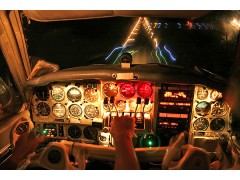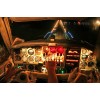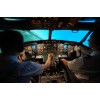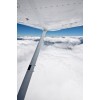Training Objectives
Each course is to be designed so that the students or the pilots under training are given the experience, the competence in flying, and the knowledge of aviation technical matters demanded by the ground and flight tests as laid down in this syllabus for the initial issue of a National Private Pilot Licence. To enable them to use the aeroplanes and facilities of the private flying environment within the privileges of the licence, in a safe and responsible manner within their own limitations.
Co-ordination of Training
The co-ordination of ground and flight training is a necessary and important part of any pilot course. Care should be exercised when conducting the course to ensure that flying training exercises are compatible with the student’s ground training progress.
Summary of Minimum Training Hours
DUAL: 22.00 hours to include: 1 hour instrument appreciation.
SOLO: 10.00 hours.
TOTAL: 32.00 hours -(Excluding Navigation Skill Test and General Skill Test)
An applicant for an NPPL must complete at least 32 hours flight time as pilot of aeroplanes. Of the 32 hours, a minimum of 22 hours dual including 1 hour of instrument appreciation and 10 hours solo must be completed. The Navigation Skill Test and General Skill Test are not included in the course hours. Of the minimum 10 hours solo, a student must complete at least four hours of solo cross country flight, including one cross country of at least 185km (100 nm) in the course of which full stop landings at two aerodromes other than the aerodrome of departure shall be made.
Entry to training
Before being accepted for training, an applicant should be informed of the medical requirements laid down prior to first solo and application for an NPPL. Minimum age for first solo: 16 years.
Minimum medical requirement to fly solo: Driver and Vehicle Licensing Agency
(DVLA) Group 1 car driving medical standards.
Minimum age for issue of NPPL (SSEA): 17 years
Minimum medical requirements to carry passengers on issue of NPPL (SSEA): A certificate of fitness from a GP, equivalent to the DVLA Group 2 professional driving medical standard.
Ground Training
This consists of all the theoretical knowledge required for the course. No mandatory lecture periods are laid down and training may consist of directed self study.
Definitions
The following definitions provide a general guide to the briefings given, but may vary in length and content dependent on the individual students’ needs.
Long Briefing
A detailed explanation and discussion conducted by the flight instructor of the major considerations of an air exercise. The normal length should be approximately 30 minutes and may be given to an individual student, or as an informal lecture to two or more students.
Pre-flight Briefing
A practical exposition by the flight instructor and lasting 10-15 minutes, on the contents of a specific flight lesson. This normally includes a statement of the aims, a brief revision of the practical aspects of any Principles of Flight involved, a statement of exactly what air exercises are to be taught by the instructor and practised by the student, and how, when and by whom the aeroplane is to be operated within the limits imposed by airmanship, weather and flight safety. These limits may vary with a particular flight and will be appropriate to the student’s stage of training. The order in which the content is given may vary according to the instructor’s judgement and the student’s experience.
Post-flight Discussion
A few minutes devoted by the instructor immediately after a specific lesson to consolidate the major points made during the flight, clarify any queries the student may have and review progress made by the student, using fault analysis or praise as necessary, and finally to indicate the nature of the next lesson.
Air Exercises
The numbering of the air exercises is to be used primarily as a reference list and instructional sequencing guide only. Demonstrations and practices need not necessarily be given in the order listed. The actual order and content will depend upon the following interrelated factors:
The student’s progress and ability ï Instructional technique considerations
The weather conditions affecting the flight ï The local operating environment.
The flight time available
Course Objectives
The course shall be designed so that student pilots are given adequate theoretical knowledge and flight training in order to ensure they are capable of safely operating an aeroplane whilst flying in weather conditions appropriate to the visual flight rules.
Course Description
The course is made up of the followings:
The theoretical knowledge syllabus which includes:
Air Law
Aeroplane General Knowledge
Flight Performance and Planning
Human Performance and Limitations
Meteorology
Navigation
Operational Procedures
Principles of Flight
Communications
These subjects shall be covered by the use of lectures or by a course of directed study including self study at home.
Flight Training
Flight instruction shall be given by flight instructors qualified in accordance with Joint Aviation Requirements-Flight Crew Licensing (JAR-FCL) and shall be sufficient to cover the required flight procedures and manoeuvres.
Cross-country flying using visual reference and dead reckoning;
Emergency operations, including simulated aeroplane equipment malfunctions;
and operations to, from and transitting controlled aerodromes, compliance with air traffic services, procedures, radiotelephony procedures and phraseology.
Navigation Skill Test
Applicants for the NPPL will be required to take and pass a Navigation Skill Test with an examiner prior to undertaking the qualifying solo cross-country flight.
General Skill Test
Applicants for the NPPL will also have to demonstrate their ability to perform procedures and manoeuvres in an aeroplane for an examiner to assess their competency to hold an NPPL.
Time limits for reference purposes for the validity periods of examinations for applicants for the National Private Pilot Licence (SSEA):
All theoretical knowledge examinations must have been completed before taking the General Skill Test and must be passed within a period of 18 months counted from the end of the month when the applicant first attempted an examination, and this pass will remain valid for licence issue for a period of 24 months from the date of successful completion of the examinations.
The General Skill Test must be undertaken within 6 months of completing the flying training, and all sections of the test must be completed within a period of 6 months.
Primary Reference Material
The Air Navigation Order LASORS
Ground Training Manuals -Trevor Thom volumes 1 – 5
AOPA NPPL














